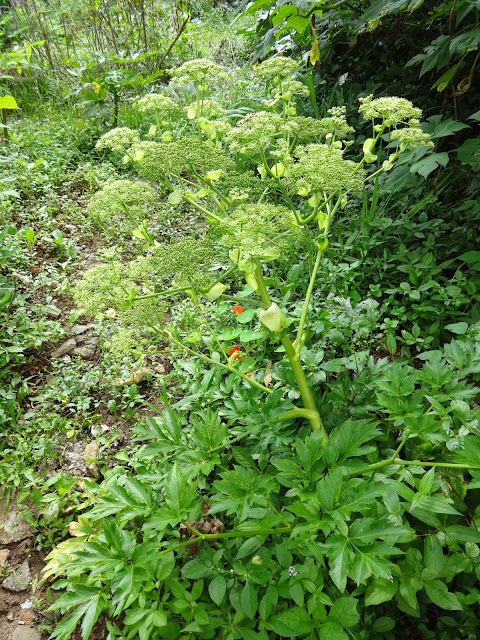
PLANT PROFILE
Ashitaba is plant from genus Angelica, and like many other plants of this genus, from different continents, this Japanese specie is edible, and has a great medicinal value used for centuries. It comes from Japan island of Hachijo-jima, where researchers/local herbalists have claimed connection between consumption of this plant with longevity of local people. Recently, this herb became popular in the Philippines ( where many plant sellers still falsely sell Gynura procumbens as Ashitaba ), it is also known in Taiwan, China and Korea, and introduced to Malaysia, Indonesia and USA. But it is still one of the most valuable yet unknown herbs and vegetables around the world. What makes Angelica keiskei unique among other valuable species of this genus, is its yellow coloured sap that contain vitamin B12 (not found in any other plant) and chalcones - bioactive compounds that are one of the strongest antioxidants.
 CULTIVATION AND HARVESTING
CULTIVATION AND HARVESTINGAngelica keiskei is one of those plants that usually produce flowers in second year, but it might do it in its first, third or fourth year as well. Soon after the seeds are fuly developed, the plant dies. But you can keep it as perennial if you will cut off its flower buds before opening. It can also grow side shoots. It grows best in partial shade and rich, compost, moist, but well drained soil, but can also cope with full sun ( as long as temperature is not too high ) and more sandy soils. It can stand frost up to -15'C, but it is going dormant in cold climate winters, that means that its leaves are dying, and new one are appearing from its root in spring. Its leafy part is usually no higher than 80cm, but flower stalk can reach over 1,5m. Leaves can be gathered at any time before it starts to turn yellow. But give it some time for small plants to get stronger before you start to pick their leaves and always leave few leaves on each plant, so it could catch some sun for further strong growth. My advise is also to dry some leaves or flowers only if you have to store them for later. Otherwise, consume it raw whenever you can, as fresh greens have always more healthy bioactive compounds.
CULINARY USES
All parts of Ashitaba can be eaten as a vegetable, raw or cooked. Fresh leaves have a unique, slightly bitter, a bit celery taste, and leaves stalks are more sweet when young. Both are excellent addiction for salads, sandwitches, or smoothies. It can also be added to soups, stews, stir-fries, sushi, dumplings and even sweets and ice creams. Roots and stalks can be pickled. It can also be dried and made into a tea, but fresh, well chopped Ashitaba can be used for infusions as well.
COSMETIC USES
 Angelica keiskei thanks to its highly antioxidant, antiseptic and antiinflammatory properties can be used as an anti-ageing skin tonic. In form of poultice (fresh smashed plant parts), juice or cosmetic preparations like creams and oils it can be applied on minor wounds, insect bites, acne, rashes, cysts, boils, pustules, smallpox, and on painfull muscles and joints to alleviate pain.
Angelica keiskei thanks to its highly antioxidant, antiseptic and antiinflammatory properties can be used as an anti-ageing skin tonic. In form of poultice (fresh smashed plant parts), juice or cosmetic preparations like creams and oils it can be applied on minor wounds, insect bites, acne, rashes, cysts, boils, pustules, smallpox, and on painfull muscles and joints to alleviate pain.MEDICINAL USES
Ashitaba has so many health benefits that it is often considered as a general tonic and profilactic panaceum, bringing longevity when consumed fresh constantly.
It strenghtens immune system and cleanses the blood, regulates cholesterol and blood sugar levels, improving circulation and reduces high blood pressure, improves visual acuity. It posses antibacterial, antiviral (even anti-HIV), antiinflammatory, laxative, diuretic and anticancer properties ( especially for skin and lung cancer ). It also stimulate new nerve growth. Angelica keiskei is traditionaly used for stomach, spleen and kidney problems, arthritis, hypertension, diabeties, smallpox, carcinoma, menstrual problems, edema and to increase milk production in breastfeeding.
It can be eaten raw, boiled (all parts included roots ), dried and used in form of infusions or tincture, or used as a poultice for wounds, skin infections, and muscle, joint and nerve pains.
Most of health benefits of Angelica kiskei are effects of chemical actions of chalcones, which are ultra strong antioxidants. These polyphenols are not found in forms present in Angelica keiskei in any other plant ( xanthoangeol, xanthoangelol E, 4-hydroxyderricin ). Other unusual compound in this herb is vitamin B12, which can't be found in any other plant (only in animals, bacterias, algae, seaweed and some mushrooms), and is necessary for healthy nervous system and formation of blood. That makes this plant especially valuable for vegetarians and people suffering aenemia. It also contain coumarins ( psoralen, imperatorin, columbiangin ), glycosides ( isoquercitin, ruteorin, angelic acid, bergapten), saponins, significant amount of melatonin and provides many healthy vitamins and minerals like beta-carotene, vitamis C, K, B1, B2, B6, calcium, magnesium, iron, germanium, zinc and potassium.




Sources
'' Plants for Fighting Cancer '' - Spiridon E. Kintzios, Maria G. Barberaki, CRC Press 2004
'' Studies in Natural Products Chemistry, Tom 39 '' - Atta-ur-Rahman, Newnes 2013
'' Issues of Biochemistry and Biophysics Research, Edition 2013 '' - Q. Ashton Acton PhD, Scholarly Editions 2013
'' Hajijo : isle of exhile '' - Shigeo Kasai, Tsune Sugimura, Weatherhill 1973
https://maykingtea.files.wordpress.com/2013/09/ashitaba-herbal-info.pdf
http://simplenewz.com/2014-08-23/Mainstream/feed/29439
http://www.ecellgen.com/index.php?option=com_content&view=article&id=20&Itemid=31
http://www.stuartxchange.com/Ashitaba.html
http://www.ashitabaplant.com/2012/10/how-ashitaba-beautifies-your-skin-and-complexion.html#.VSybwfmsWuI
http://www.ashitabaplant.com/2012/10/how-ashitaba-beautifies-your-skin-and-complexion.html#.VS3bO_msWuJ
http://www.sadgurupublications.com/ContentPaper/2010/73_8(1)2010.pdf
http://www.ashitaba.com/.sc/ms/cat/FAQ--More%20......#What is Ashitaba
https://www.youtube.com/watch?v=lgWs4Z4pMWI
http://www.mb.com.ph/the-real-ashitaba-now-here/
http://www.mb.com.ph/observations-on-growing-ashitaba/
http://homeguides.sfgate.com/grow-ashitaba-75807.html
http://www.jbsl-net.com/english/products/products03.html
http://www.ashitababeauty.com/


































